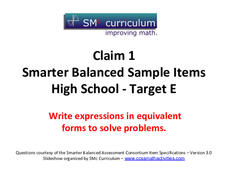CCSS Math Activities
Smarter Balanced Sample Items: High School Math – Target F
All polymaths know about polynomials. Scholars look at six problems aligned to the SBAC Claim 1 Target F for high school. They must perform operations on polynomials, including problems where the coefficient is a letter. The presentation...
CCSS Math Activities
Smarter Balanced Sample Items: High School Math – Target E
Pupils rewrite expressions in equivalent forms to identify key features. They use the vertex and factored forms of quadratic expressions to identify the extrema and intercepts. To finish the installment of the Claim 1 Item Slide Show...
CCSS Math Activities
Smarter Balanced Sample Items: High School Math – Target C
Let units pave the way to success. A set of five questions in a helpful PowerPoint presentation highlights the SBAC Claim 1 Target C high school item specifications. It covers the use of units to steer solutions, identifying appropriate...
CCSS Math Activities
Smarter Balanced Sample Items: High School Math – Target A
Don't get irrational about rational exponents. A PowerPoint presentation highlights the sample high school questions from the Smarter Balanced Assessment Consortium (SBAC) Claim 1 Target A item specifications. As one part of a larger...
CCSS Math Activities
Smarter Balanced Sample Items: High School Math – Target B
There are only two options to consider: rational or irrational. Pupils review rational and irrational numbers by answering a set of eight questions provided in a PowerPoint presentation. Part of larger Claim 1 Item Slide Show series, the...
Corbett Maths
Coordinates and Shapes
Where is the point? Given three points on the coordinate plane, the video walks through the steps to find the location of the fourth point to create a given special quadrilateral. The narrator first determines the coordinates of the...
Corbett Maths
Loci Part 2
Closer to this point and farther from that one. Continuing with loci problems, a short video shows how to work problems that are not straightforward. The presenter works loci problems that result in a region that meets several criteria.
Corbett Maths
Construct a 45 Degree Angle
Create a 45-degree angle without bisecting an angle. A video shows a method to construct a 45-degree angle without needing to bisect a right angle. By constructing an isosceles right triangle, the presenter constructs a 45-degree angle...
Corbett Maths
Construct a 30 Degree Angle
Split it down the middle. Using the tools of geometric construction, the video shows two different methods of constructing a 30-degree angle. The first method bisects an angle of an equilateral triangle. The second uses the diagonal of a...
Corbett Maths
Medians and Quartiles from Grouped Frequency Tables and Histograms
Determine medians within a group. Given data represented as a frequency table of grouped data, the video demonstrates finding an estimation for the median. After finding the group where the median resides, the presenter uses a formula to...
Corbett Maths
Angle Bisector
Cut it in half with a compass and straightedge! Using construction tools, a video shows how to create an angle bisector. The presenter points out what it means to bisect an angle in terms of the measure and distances from the sides of...
Corbett Maths
Constructing SSS Triangles
Creating a triangles is as easy as 5, 6, 7. Using a ruler and compass to measure off lengths, a short video shows how to construct a triangle with three specific side lengths. The example creates a triangle with side lengths of 5 cm, 6...
Corbett Maths
Constructing SAS Triangles
Two sides and an angle ... a triangle it makes. Given the measure to two sides and the angle between them, the narrator of a short video shows how to draw a triangle with a ruler and protractor. Pupils use handouts to practice the newly...
Corbett Maths
Enlargements with Negative Scale Factor
How will a scale factor affect a figure—negatively? Using a grid, the narrator of an engaging video performs a dilation with a negative scale factor. The presenter compares a positive scale factor with a negative scale factor to explain...
Corbett Maths
Constructing ASA Triangles
The narrator of a short video explains the steps in constructing a triangle given the measure of two angles and the length of the side between the angles. The resource provides opportunities for pupils to practice the skill with two...
Corbett Maths
Perpendicular from a Line to a Point
Take steps in the right direction. With a short demonstration, a video shows the steps to construct a perpendicular from a line to a point. Using a protractor, the narrator confirms the resulting construction is perpendicular, and then...
Corbett Maths
Perpendicular Through a Point on a Line
Use one construction to complete a second. The short video shows how to incorporate the steps of a perpendicular bisector to create a perpendicular to a point on a line. With their own straightedges and compasses, classmates then...
Corbett Maths
Perpendicular Bisector
Where should the statue be located? The resource explains how to use a compass and straight-edge to construct the perpendicular bisector of a line segment. Using an exam question, the narrator models how to solve an application problem...
Corbett Maths
Enlargements Using Ray Method
Figure out what to do when there is no grid to count. Using a ruler and a sharp pencil, the narrator shows how to perform a dilation when the figure is not on a grid. The ray method works by drawing a ray from the center of dilation...
Corbett Maths
Enlargements with Fractional Scale Factors
Enlargements make it bigger, right? A video shows viewers how to perform a basic dilation with a fractional scale factor. They learn how to use the scale factor to find the location of the transformed vertex by multiplying the horizontal...
Corbett Maths
Finding the Centre of Enlargement
Where did the transformation begin? Using a ruler, the narrator of a short presentation shows how to find the center of enlargement for transformed figures. Worksheets provide the class members an opportunity to practice the newly...
Corbett Maths
Describing Enlargements
What caused that to happen? Using three aspects, a video demonstrates how to describe an enlargement or dilation. The presenter counts the lengths of the sides to determine the scale factor and a ruler to find the center of dilation.
Corbett Maths
Enlargements
Count on the scale to enlarge a figure. The video shows how to create an enlargement given a scale factor and a center of enlargement. The presenter multiplies the vertical and horizontal distance by the scale factor to find the new...
Concord Consortium
Full of Beans
Scholars have an opportunity to use their geometric modeling skills. Pupils determine a reasonable estimate of the number of string beans that would fill the average human body.

























